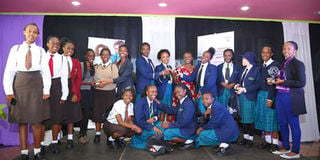We need more girls, women in Stem

The winners of 2018 Technovation pitch Nairobi Region competition - Mary Hill School, M-Pesa Foundation Academy and Buruburu Girls students - present their awards. The challenge encourages young women to pursue science, technology, engineering and mathematics (Stem). PHOTO | FILE | NATION MEDIA GROUP
What you need to know:
- We need to harness talent and dismantle all barriers that discourage girls from pursuing fields relating to science, technology, engineering and mathematics (Stem).
- Stem drives economic growth. In the past decade, prioritising investments in Stem has delivered innovation and self-employment.
When the curtains fell on the national science competition in July last year, Sophia Medza and Bakayo Koncharo, of Moi Girls High School, in Marsabit County, were on the roll of honour.
Inspired to tackle environmental pollution, these young minds had created building blocks from non-biodegradable polymers.
Their grander dream is to upscale production to contribute towards more affordable housing in Kenya and one of the national ‘Big Four Agenda’ items.
Another pair of inspiring students from the Young Scientists Kenya (YSK) innovators’ competition is Esther Nduta and Lydia Njeri, of Bethlehem Senior School, in Kiambu County, who designed a disposable toothbrush and a natural organic antiseptic mouthwash to prevent tooth decay, gum disease and other common dental diseases.
INNOVATION
On the International Women’s Day tomorrow, the incentives for Sophia, Bakayo, Esther and Lydiah will more than be on stage when the whistle blows and the crowds applaud; being proud to be part of a generation of girls and women who triumph over mathematics and sciences.
This year’s theme, “Think equal, build smart, innovate for change”, explores the need to encourage innovative ways for girls and women to take up the places that will shape future societies by challenging and removing the structural barriers with no girl or woman being left behind.
Innovations can remove barriers and accelerate progress for gender equality, encourage investment in gender-responsive social systems and build services and infrastructure that meet the needs of girls and women.
Girls and women play a critical role in science, technology and innovation.
TALENT
Nobel laureate Wangari Maathai (1940-2011) was the first woman in East and Central Africa to earn a doctoral degree and later became chairperson of the Department of Veterinary Anatomy.
In another first, in 1976, she became an associate professor. She later founded the Green Belt Movement before gaining global acclaim as the 2004 Nobel Peace Prize winner.
Prof Maathai’s feats stand as a testament to what girls and women can achieve.
Unesco estimates that women represent less than 30 percent of the research and development workforce.
To bridge this gap, we need to harness talent and dismantle all barriers that discourage girls from pursuing fields relating to science, technology, engineering and mathematics (Stem).
We need to encourage them to participate in Stem education, training and research at all levels.
MENTORS
For her doctoral studies in 2016, Lucy Wandiri explored ways to enable access and participation of female students in Stem-based courses at Kenyan public universities.
She found that, despite the educational gender interventions, their enrolment and participation in Stem disciplines is 30 percent and less than 20 percent in hard sciences.
The study highlighted existing socio-cultural and institutional barriers that affect female students’ participation in Stem fields.
Wandiri calls for the appointment of more female faculty members to act as mentors to female students and encourage the students to grow into problem solvers, inventors and self-reliant and logical thinkers.
She recommends complementary educational Stem policies and interventions, a gender-friendly Stem curriculum and learning environment, financial aid for needy female Stem students, as well as the elimination of stereotypes and prejudices on the ‘masculinity’ of Stem.
LINCHPIN
YSK is an excellent example of a platform that showcases innovation and develops interests and talents in Stem.
The initiative aims at building a strong foundation for young scientists in secondary school and hopes to bring together 470 students from 235 schools from all counties to showcase their innovations this year.
Stem drives economic growth. In the past decade, prioritising investments in Stem has delivered innovation and self-employment. We must redouble our efforts to boost the number of girls and women in Stem.
By harnessing their skills and smart ideas, we will realise important progress towards the Sustainable Development Goals (SDGs) and a more peaceful, just and prosperous world.
SUPPORT
Learners need more impetus to attain excellence. Progressive leadership is a product of synergy that begins from the doorsteps of our homes and to national borders.
The yardstick of overall merit in Kenya lies in leaving no one behind. The words of Prof Maathai challenge us to mentor more girls in Stem, for IWD and everyday.
Let us hear and adhere to her clarion call, “We cannot tire or give up. We owe it to the present and the future generations of all species to rise up and walk!”
Mr Schultink is The Representative of Unicef in Kenya. Ma Chartres is the Australian High Commissioner.





